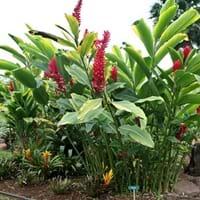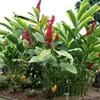Life Span
Perennial
Perennial
Type
Tender Perennial
Bulb or Corm or Tuber
Origin
Melanesia, Micronesia, Polynesia
South America, Argentina
Types
not available
Not Available
Habitat
Humid climates
Temperate Regions
USDA Hardiness Zone
9-15
5-9
Sunset Zone
H1, H2, 14, 15, 16, 17, 18, 19, 20, 21, 22, 23, 24
21,22
Habit
Upright/Erect
Clump-Forming
Flower Color
White, Red, Pink
Light Blue, Light Purple, Silver, Sky Blue
Flower Color Modifier
Not Available
Bicolor
Fruit Color
Not Available
Not Available
Leaf Color in Spring
Green, Dark Green
Green, Light Green, Gray Green
Leaf Color in Summer
Dark Green
Light Green
Leaf Color in Fall
Dark Green
Several shades of Green
Leaf Color in Winter
Dark Green
Light Green
Leaf Shape
Oblong
Grass like
Plant Season
Spring, Summer, Fall, Winter
Spring
Sunlight
Partial Sun, Partial shade
Full Sun, Partial Sun, Partial shade
Type of Soil
Loam, Sand
Clay, Loam, Sand
The pH of Soil
Acidic, Neutral
Acidic, Neutral, Alkaline
Soil Drainage
Average
Well drained
Bloom Time
Indeterminate
Early Spring, Spring, Late Winter
Tolerances
Drought
Drought
Where to Plant?
Container, Ground, Pot
Container, Ground
How to Plant?
From Rhizomes, Seedlings
By dividing rhizomes, tubers
Plant Maintenance
Low
Medium
Watering Requirements
Keep the ground moist but not water-logged
Average Water Needs, Do Not over Water, Requires regular watering
In Summer
Lots of watering
Lots of watering
In Spring
Moderate
Moderate
In Winter
Average Water
Average Water
Soil pH
Acidic, Neutral
Acidic, Neutral, Alkaline
Soil Type
Loam, Sand
Clay, Loam, Sand
Soil Drainage Capacity
Average
Well drained
Sun Exposure
Partial Sun, Partial shade
Full Sun, Partial Sun, Partial shade
Pruning
Remove damaged leaves, Remove dead branches, Remove dead leaves
Remove damaged leaves, Remove dead branches, Remove dead leaves
Fertilizers
All-Purpose Liquid Fertilizer, Fertilizer every month during spring, Requires high amount of nitrogen, since leafy plants, use higher nitrogen content fertilizer
All-Purpose Liquid Fertilizer
Pests and Diseases
Aphids, Earwigs, fungus, Mealybugs, Nematodes, Red blotch, Root rot, Scale, Thripes
Slugs, Snails
Plant Tolerance
Drought
Drought
Flower Petal Number
Single
Single
Fragrant Bark/Stem
Yes
No
Foliage Texture
Bold
Medium
Foliage Sheen
Matte
Matte
Attracts
Not Available
Bees, Birds, Hummingbirds
Allergy
Not Available
Not Available
Aesthetic Uses
Landscape Designing, Showy Purposes
Showy Purposes
Beauty Benefits
Not Available
Not Available
Environmental Uses
Air purification
Air purification
Medicinal Uses
Antirheumatic, Appetite enhancer, Asthma, Bronchitis, Cold, Headache, Laxative, Muscle Pain, Sore throat, Sweat bullets, Tonsillitis
No Medicinal Use
Part of Plant Used
Flowers, Root bark
Flowers
Other Uses
Culinary use, Used as Ornamental plant
Not Available
Used As Indoor Plant
No
Yes
Used As Outdoor Plant
Yes
Yes
Garden Design
Container, Cutflower, Feature Plant, Foundation, Mixed Border, Tropical
Container, Lawns and Turf, Mixed Border, Rock Garden / Wall, Wildflower
Botanical Name
ALPINIA purpurata
Ipheion uniflorum
Common Name
Jungle Queen, Red Ginger
Spring Starflower, Springstar
In Hindi
लाल अदरक
Spring Starflower
In German
Red Ginger
Frühling Borretsch
In French
Red Ginger
Spring Starflower
In Spanish
Red Ginger
primavera Flor de estrella
In Greek
Red Ginger
άνοιξη starflower
In Portuguese
Red Ginger
primavera Starflower
In Polish
Red Ginger
Wiosna Starflower
In Latin
Gingiberi Rubrum
Spring Starflower
Phylum
Magnoliophyta
Magnoliophyta
Class
Liliopsida
Lilopsida
Order
Zingiberales
Asparagales
Family
Zingiberaceae
Liliaceae
Clade
Angiosperms, Commelinids, Monocots
Angiosperms, Monocots
Tribe
Alpinieae
Gilliesieae
Subfamily
Alpinioideae
Allioideae
Number of Species
Not Available
Not Available
Importance of Red Ginger Plant and Spring Starflower
Want to have the most appropriate plant for your garden? You might want to know the importance of Red Ginger Plant and Spring Starflower. Basically, these two plants vary in many aspects. Compare Red Ginger Plant and Spring Starflower as they differ in many characteristics such as their life, care, benefits, facts, etc. Every gardener must at least have the slightest clue about the plants he wants to plant in his garden. Compare their benefits, which differ in many ways like facts and uses. The medicinal use of Red Ginger Plant is Antirheumatic, Appetite enhancer, Asthma, Bronchitis, Cold, Headache, Laxative, Muscle Pain, Sore throat, Sweat bullets and Tonsillitis whereas of Spring Starflower is No Medicinal Use. Red Ginger Plant has beauty benefits as follows: Not Available while Spring Starflower has beauty benefits as follows: Not Available.
Compare Facts of Red Ginger Plant vs Spring Starflower
How to choose the best garden plant for your garden depending upon its facts? Here garden plant comparison will help you to solve this query. Compare the facts of Red Ginger Plant vs Spring Starflower and know which one to choose. As garden plants have benefits and other uses, allergy is also a major drawback of plants for some people. Allergic reactions of Red Ginger Plant are Not Available whereas of Spring Starflower have Not Available respectively. Having a fruit bearing plant in your garden can be a plus point of your garden. Red Ginger Plant has no showy fruits and Spring Starflower has no showy fruits. Also Red Ginger Plant is not flowering and Spring Starflower is not flowering . You can compare Red Ginger Plant and Spring Starflower facts and facts of other plants too.





